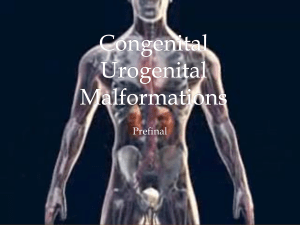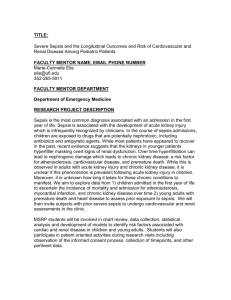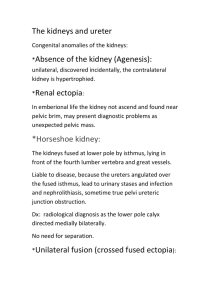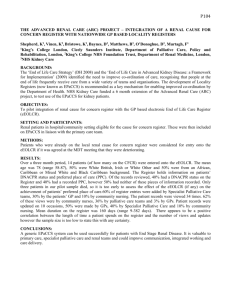File - Ms.Francois` Anatomy & Physiology Class
advertisement
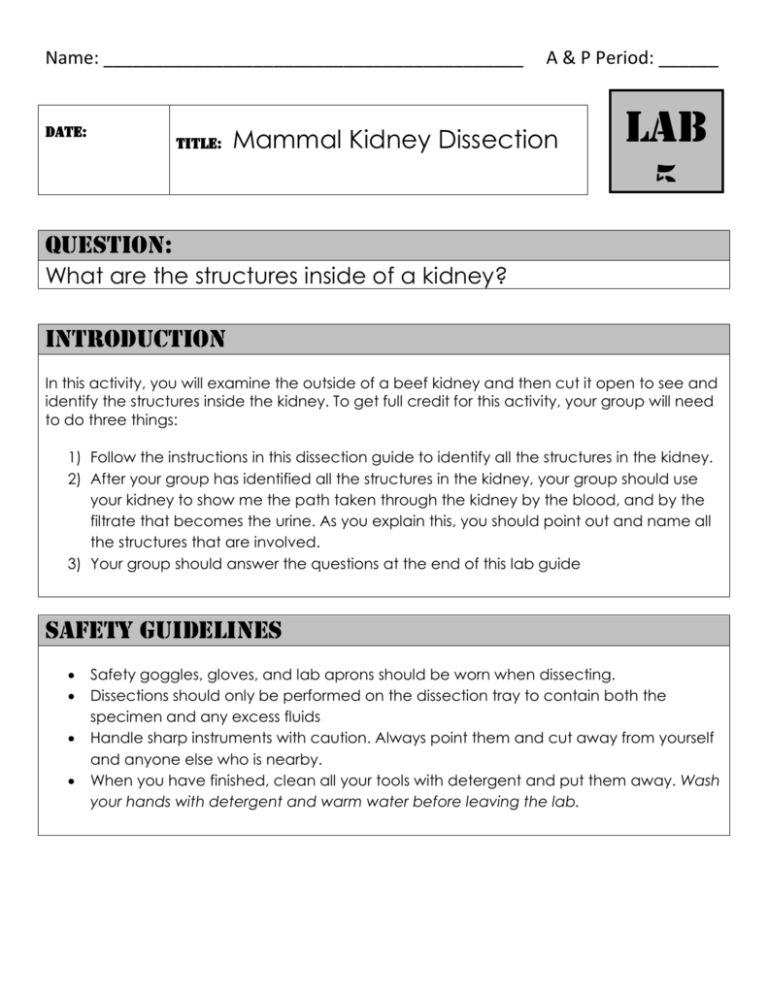
Name: __________________________________________ Date: Title: A & P Period: ______ Mammal Kidney Dissection Lab 5 Question: What are the structures inside of a kidney? Introduction In this activity, you will examine the outside of a beef kidney and then cut it open to see and identify the structures inside the kidney. To get full credit for this activity, your group will need to do three things: 1) Follow the instructions in this dissection guide to identify all the structures in the kidney. 2) After your group has identified all the structures in the kidney, your group should use your kidney to show me the path taken through the kidney by the blood, and by the filtrate that becomes the urine. As you explain this, you should point out and name all the structures that are involved. 3) Your group should answer the questions at the end of this lab guide Safety guidelines Safety goggles, gloves, and lab aprons should be worn when dissecting. Dissections should only be performed on the dissection tray to contain both the specimen and any excess fluids Handle sharp instruments with caution. Always point them and cut away from yourself and anyone else who is nearby. When you have finished, clean all your tools with detergent and put them away. Wash your hands with detergent and warm water before leaving the lab. Page 2 Materials: A kidney Storage bag Dissecting tray Dissecting instruments (scalpel, dissecting scissors, forceps, dissecting needle, probe, dissecting pins) Gloves Lab apron Safety goggle procedure: Review the glossary provided at the end of this dissection guide. Part 1: EXTERNAL ANATOMY 1. Examine the outside of the kidney. The ureter, renal artery, and renal vein all enter the kidney in the same area. If they are present, the ureter can be identified by the larger amount of adipose tissue that is usually attached to it. 2. Identify the ureter, renal artery, and renal vein if they are present. 3. Observe the renal capsule and adipose capsule. 4. Find the renal hilus. This is the “pinched-in” area where renal blood vessels and the ureter attach to the kidney. Q1) Describe the renal hilus. Can you tell the difference between the renal artery, renal vein, and ureter? What do each of them look like? Q2) How does the Renal Capsule look and feel? What do you think the function of the renal and adipose capsules are? Draw a simple sketch of the external view of the kidney, labeling the hilus. Page 3 Part 2: REMOVAL OF THE RENAL CAPSULE Carefully, using the forceps, pinch the renal capsule and make a small incision with the scissors to start a hole in the capsule. Using the scissors and forceps, remove the capsule Part 3: FRONTAL SECTION OF THE KIDNEY 1. Letting the kidney lie flat as shown in the figure at left, cut the kidney in half lengthwise from the side. Do not cut until you have checked and are sure of the correct direction of your cut—As a surgeon, you only get one chance to cut, and there is no way to redo this. 2. Splitting the kidney in half will reveal its internal structures. Page 4 Part 4: INTERNAL ANATOMY OF THE KIDNEY Use flagged pins to identify the following parts of the internal kidney: Cortex Renal Column Medullary Pyramid Minor Calyx Major Calyx Renal Pelvis Ureter Renal Artery Renal Vein There are several parts to the kidney, as show at right. From the outside to the center of the kidney, find each of the following in your specimen: The renal cortex is the solid-looking outermost part of the kidney. It contains many small arteries and veins that carry blood to and from approximatly one million nephrons located in the cortex. The medulla is the region located inward from the cortex. It includes the cone-shaped renal pyramids. These are the fibrous or striped triangular zones in the medulla that contain the colleting ducts, which collect urine from the kidney tubules of the nephrons in the cortex. Between the pyramids are the renal columns that contain middlesized arteries and veins that carry blood between the nephrons in the cortex and the renal artery and vein. The hollow area in the center of the kidney is the renal pelvis, which should not be confused with the bone called the pelvis. The collecting ducts drain into the pelvis. From there, the urine passes out through the ureter to the urinary bladder. DO NOT MOVE ON UNTIL YOUR INSTRUCTOR HAS SIGNED OFF ON YOUR Flags! Page 5 Part 5: BLOOD PATHWAY OF THE KIDNEY After you have identified all the structures in the kidney, work with your group to trace the path taken through your group’s kidney by the blood, and by the filtrate that becomes the urine. As you do this, point out and name all the structures that are involved. When your group is satisfied that you can do this well, your group should use the kidney to explain it to me. In a paragraph, trace a drop of blood from the time it enters the kidney in the renal artery until it leaves the kidney through the renal vein. DO NOT MOVE ON UNTIL YOUR INSTRUCTOR HAS SIGNED OFF ON YOUR SECTION 5! Part 6: CLEAN-UP 1. When you have finished using the kidney, I will give you some plastic to wrap it up. Clean all your equipment thoroughly with detergent and water and return it. Use paper towels, detergent, and water to clean up your work area. All group members are responsible for clean up. Page 6 2. After your group has finished cleaning up, wash your hands well with detergent and water. DO NOT MOVE ON UNTIL YOUR INSTRUCTOR HAS SIGNED OFF ON YOUR CLEAN UP! Part 7: FOLLOW-UP QUESTIONS 1. What is the main function of the kidney? 2. What is the function of the fat that surrounds the kidneys? 3. How did you distinguish between the renal artery and the renal vein? 4. Which area of the kidney contains the glomeruli and Bowman’s capsules? 5. Where are the adrenal glands located? What is their function? 6. In which part of the kidney does the majority of water reabsorption occur? Page 7 7. What structure carries urine out of the kidney and where does it go? Part 8: KIDNEY LABELLING Page 8 Page 9 Page 10 Group work reflection: Roles: (4 pts) Please put first AND last name! 1. Task Manager: __________________________________________________ 2. Spokesperson: _________________________________________________ 3. Data Collector: _________________________________________________ 4. Resource Manager _____________________________________________ Checklist: (4 pts) Did each person play a part in the lab and on task? Did you follow safety rules? Were all parts of lab completed? Was group workspace cleaned up? Answer the following questions: (10 pts) What worked well the most during the assignment for the group? What did not work so well during the assignment for the group? Where did you disagree as a group or saw mistakes in each other’s work? What will you do next time to improve how your group worked together? How much did you as an individual participate in the group? What can you do next time to improve your own performance in the lab group? Page 11 Group Rubric: Contribution Cooperation On task Communication Total Score: Poor 1 point Developing 2 points Good 3 points Excellent 4 points One or more members do not contribute. All members contribute, but some contribute more than others. All members contribute equally. All members contribute equally, and some even contribute more than was required. Teacher intervention needed often to help group cooperate. Members work well together some of the time. Some teacher intervention needed. Members work well together most of the time. All members work well together all of the time; assist others when needed. Team needs frequent teacher reminders to get on task. Team is on task some of the time. Needs teacher reminders. Team is on task most of the time. Does not need any teacher reminders. Team is on task all of the time. Does not need any teacher reminders. Members need frequent teacher intervention to listen to each other and speak to each other appropriately. Members need some teacher intervention to be able to listen to each other and speak to each other appropriately. All members listen to each other and speak to each other in equal amounts. Each member listens well to other members. Each member speaks in friendly and encouraging tones. /32 TOTAL SCORE ON REFLECTION: _________/50 GROUP RATING: _________/32 Completion of Lab: ____________/50 Overall Score on Lab: _____________ Group Rating (YOU RATE) /16 Teacher Rating /16 Page 12 Glossary Calyx - cup-like division found in the renal medulla; minor calyces (plural) empty into major calyces. Hilus - depression where the renal artery, renal vein, and ureter enter and exit the kidney. Renal artery - branch from the abdominal aorta that supplies the kidney with oxygenated blood. Renal capsule - dense, irregular connective tissue layer that protects the kidney and helps maintain its shape. Renal corpuscle - glomerulus enclosed within a glomerular capsule; site of filtration. Renal cortex - outer region of the kidney. Renal lobe - consists of a pyramid, portion of the cortex at the pyramid base, and a portion of the adjacent renal column. Renal medulla - inner portion of the kidney. Renal papilla - apex of a renal pyramid; continuous with the minor calyx. Renal pelvis - large cavity that receives urine from major calyces; continuous with ureter. Renal pyramid - cone-shaped structure found in the medulla with its base facing the cortex and the apex facing the hilus. Renal vein - blood vessel exiting the kidney carrying filtered, deoxygenated blood to the inferior vena cava. Ureter - tube that connects the kidney to the urinary bladder.





